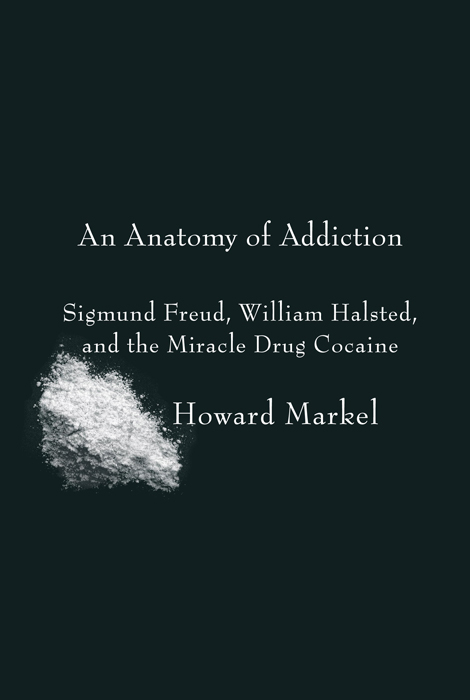
An Anatomy of Addiction
Sigmund Freud, William Halsted, and the Miracle Drug Cocaine
سیگموند فروید، ویلیام هالستد، و معجزه مواد مخدر
کتاب های مرتبط
- اطلاعات
- نقد و بررسی
- دیدگاه کاربران
نقد و بررسی

Starred review from April 18, 2011
In the 1880s, Sigmund Freud, the founder of psychoanalysis, and William Halsted, the founder of modern surgery, independently and personally discovered the powerful anesthetic, and terribly addictive, effects of cocaine. Markel (Quarantine!), a medical historian at the University of Michigan, eloquently tells the parallel stories of these two pathbreaking physicians and how their stories intersect in remarkable and sometimes tragic ways. The ready availability of cocaine starting in the 1860s drove Freud to experiment with the drug as an antidote to morphine addiction. Using cocaine to treat his own migraines and anxiety, he became addicted. At about the same time, when surgery remained dangerous because of easy infection and the lack of effective anesthetics, William Halsted in New York discovered the anesthetic effects of cocaine, and it appeared that the latter problem was solved; however, experimenting with cocaine himself, Halsted steadily sunk into such a terrible addiction that his brilliant career as a surgeon ended. Reviewing debates over the impact of addiction on the two physicians and why they fell prey to cocaine, Markel concludes simply and fairly that even these "intellectual giants were all too human." Markel's extraordinary achievement combines first-rate history of medicine and outstanding cultural history. Illus.

May 15, 2011
Medical historian Markel (Medicine/Univ. of Michigan; When Germs Travel, 2004, etc.) writes of a time when many Americans and Europeans enjoyed their daily rendezvous with cocaine.
Two of them were giants: Sigmund Freud and William Halsted, and no history of their fields—psychology and surgery—is complete without considering their contributions, for "each man changed the world." They were also both cocaine addicts for part of their lives, and Markel investigates how that condition may have impinged on their work. The author is a convivial writer, but careful with his data; he musters his facts, then deals them out with a pleasurable flourish. He situates both the rise and fall of cocaine in the medical world, and that world writ large during the late 19th century, as well as broadly exploring each man's significance to medicine. Markel ably covers cocaine's effects as it made its way into the surgery—it was the anesthesiologist's godsend—as well as Freud and Halsted's bloodstreams. Reports of its revivifying powers had been floating out of South America since the early 19th century, and the substance gradually came into everyday use. Markel is particularly good with the social history of the drug: how it was laced into wine and Coca-Cola (as a response to the outlawing of liquor in Georgia), and the same-as-it-ever-was shenanigans of Big Pharma. Freud and Halsted, however, are cautionary tales as self-experimenters: Cocaine's progress played upon their insecurities and vanities, exacted physical and emotional tolls and disrupted their personal lives, not to mention that "their most fallow professional years coincided with their most prodigious substance abuse."
From wonder drug to the monkey on their back, Markel testifies that cocaine did neither Freud nor Halsted any favors.
(COPYRIGHT (2011) KIRKUS REVIEWS/NIELSEN BUSINESS MEDIA, INC. ALL RIGHTS RESERVED.)

May 1, 2011
It is well known that Freud, before becoming the founder of psychoanalysis, wrote about the medical uses of cocaine and did a good deal of experimentation with the drug himself. At about the same time, as Markel (George E. Wantz Distinguished Professor of the History of Medicine, Univ. of Michigan) relates, Halsted, a pioneering young American surgeon, also began experimenting with cocaine, self-injecting it to learn how to standardize the dosage. He became seriously addicted and eventually was placed in a mental hospital after all other attempts to control his drug use failed. Despite a prestigious medical career, he continued to use cocaine and morphine throughout his life. Freud, on the other hand, seems to have stopped his cocaine use on his own. There is an interesting story here about the history and sociology of medicine and drug use, but Markel doesn't pursue it; instead, he shoehorns the facts (and gossip) about the two men into a modern, 12-step view of addiction. VERDICT If you already know something about the history of medicine or drug use or have read biographies of either scientist, you may enjoy disagreeing with this book. But there are plenty of better places to start on all of these topics.--Mary Ann Hughes, Shelton, WA
Copyright 2011 Library Journal, LLC Used with permission.

June 1, 2011
University of Michigan professor Markel's compelling and compassionate account of these two icons in the annals of medicine and their shared addictions profoundly demonstrates the complexity and breadth of their genius. Picture Halsted, the surgeon, desperate to perform painless, perfect surgeries but with too few available painkilling options. Picture Freud, a physician eager to blaze new boulevards into the physiological and psychological aspects of the mind. Each man a wizard, a driven spirit who will stop at nothing, not even self-experimentation, in order to excel in his field. Picture the then recently discovered drug cocaine, an established painkiller, an extraordinary mood and stamina enhancer. Picture its appeal to each of these overachievers who unwittingly, helplessly addict themselves to its seductive superpower. How does genius intersect with the drug, for better or for worse? Markel's anatomy is a richly woven analysis complete with anecdotes, historical research, photos, and present-day knowledge about the character of the addictive personality.(Reprinted with permission of Booklist, copyright 2011, American Library Association.)

























دیدگاه کاربران